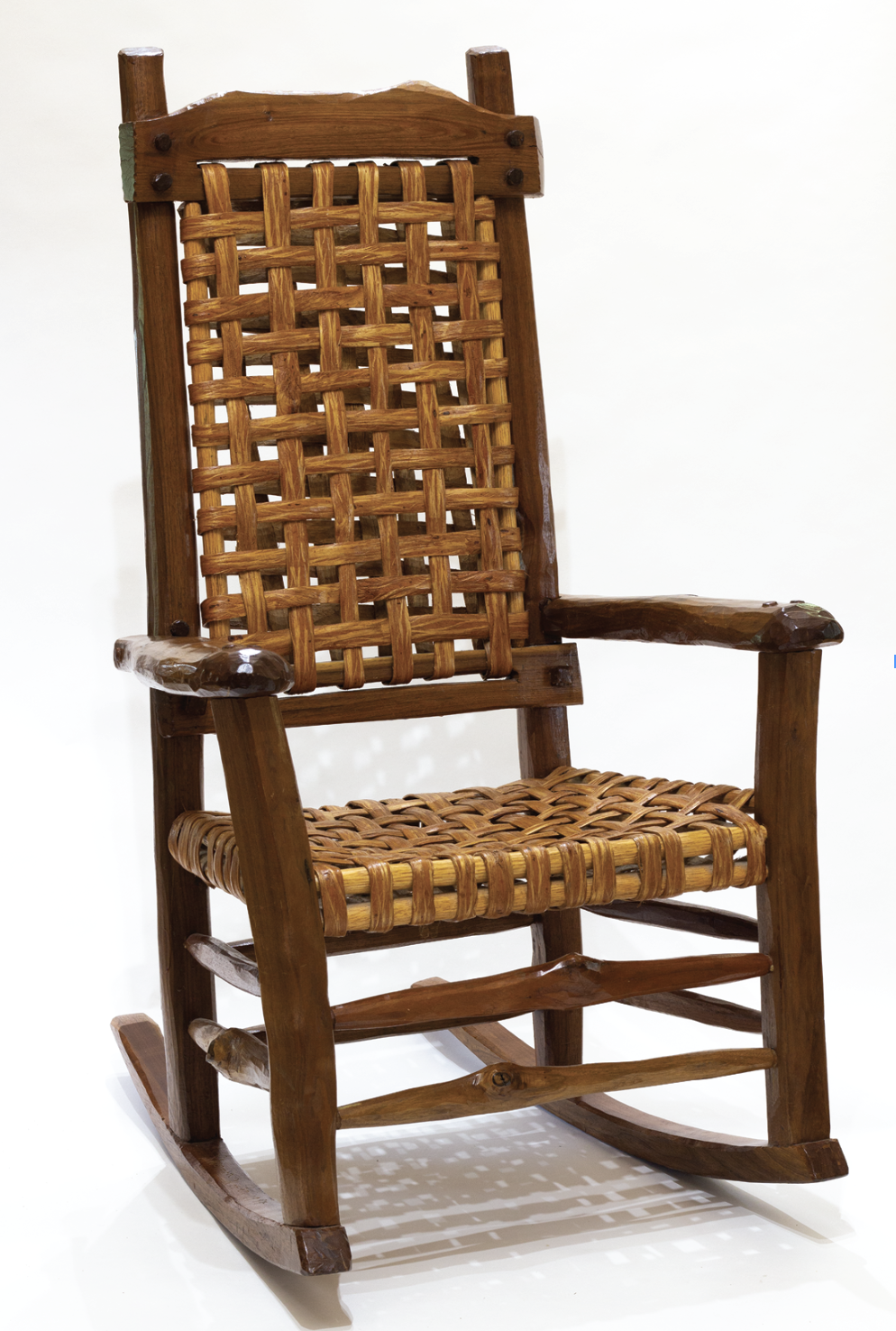The following is excerpted from Andrew D. Glenn’s “Backwoods Chairmakers: In Search of the Appalachian Ladderback Chairmaker.”
For more than 200 years, chairmakers in Appalachia built ladderbacks to sell to neighbors and the occasional tourist. It was a tradition that was handed down through generations. But with the rise of furniture factories and mechanization, woodworker Andy D. Glenn wondered if there were any traditional chairmakers left. So he set off into the mountains with a camera and a tape recorder. There, he found many still working the craft – some by hand, and others who have added machines to their workshops.
Part travelogue, part profile and part how-to, “Backwoods Chairmakers” explores the tradition of this enduring form. Glenn takes you inside the shops of more than 20 makers, with photos and personal interviews about their lives and techniques.
Then, Glenn shows you how to make a post-and-rung side chair and rocking chair using the traditional techniques explored in the book.
“I come from a long line of good ol’ boys and strong women who were yeoman farmers first and foremost, and makers out of necessity. They made chairs, furniture and wagons, and were blacksmiths and toolmakers, carpenters – both rough and finish – sawyers and farm-implement makers. One grandfather started out in the family wagon business after completing the eighth grade, and by the early 1930s they were out of business as the carriage went horseless.”
— Lyle Wheeler

The Appalachian ladderback goes by different names, depending on the region and the maker’s preference. “Post and rung” is the umbrella term used to describe these chairs, but during my travels only a single chairmaker called it that. Post and rung refers to the construction method: vertical posts receive horizontal rungs. And it refers to any chair design of similar fashion, whether made in Appalachia or elsewhere.
Instead, I heard the chair called a split bottom, common chair, mule ear, settin’ chair, ladderback, hickory bottom, woven chair or mountain chair. Or, as one maker put it, “It’s simply a chair.” The terms all refer to the same style: rungs below, some of which create a frame for a seat, and slats above to support the back. It’s a simple form, familiar to anyone in the region, with each chairmaker or shop adding distinctive details.
It’s also a form that requires only a few tools. A skilled chairmaker could fashion a chair with as little as an axe, bit and brace and a pocketknife. This made the form ideal in the mountains of Appalachia. Drew Langsner (Chapter 8) describes the form as the first chair an Appalachian family would add to their home, “…from no chairs to this chair.” It was the evolutionary first step.

There is no single definitive Appalachian chair style, though there are characteristics found on chairs throughout the region. For each example of a characteristic, there are multitudes of counter examples. A typical Appalachian mountain chair uses a combination of these characteristics, with each chair style determined by the maker’s preferences and the style of the region.
One defining characteristic of an Appalachian chair is the restrained use of ornamentation. The vertical posts, when turned, may have a few details left by the turner, but most shaved chairs are left plain. The “foot,” or lower posts near the floor, frequently taper toward the end to give a more delicate appearance.
The back posts might have a finial – turned chairs are more likely to possess the finial than shaved ones.

The back posts are either straight or bent. The bend adds considerable comfort to the chair, and Appalachian chairmakers claim the bent back posts are their distinct contribution to the ladderback form. The bend comes from a natural wind in a tree, or, most frequently, from the chairmaker steaming or boiling the back posts before bending them on a form.
The last common characteristic is the woven seat, often from hickory bark, though chairmakers also used seagrass, flat reed, paper cord, cotton tape or corn shuck (though I didn’t find a contemporary maker using corn shuck). Hickories are abundant in Appalachia. Though collecting the bark is hard on the back and hands, the material can be harvested within a maker’s community.

The Chair’s Joinery
The chair’s durability, essential to its long-term success, is determined by the post-and-rung joinery. Round joints are frequently derided within woodworking circles for wiggling loose and failing. That derision is not without merit. One reason the joint fails is that nearly all the glue surfaces within the joint contain end grain. Drill a hole, glue in a same-diameter dowel, put it under the stresses of a typical chair and the glue will fail. The tenon works loose.
There is a simple trick to add strength when building the chair: manipulate the moisture difference between the rungs (dry) and posts (wetter). Wood shrinks when it dries. The wet post shrinks, holding the rung ever tighter as it dries. The rung, if dried below the moisture content in the air, will swell once in the chair. Each chairmaker I visited described this technique to me. They used shorthand when describing the process, often simply calling it “green wood.”

The Wood & How it’s Used
The chairmakers I visited use local materials, most often oak, hickory, maple, cherry and walnut. Most collect their own logs or work closely with a trusted logger. Extreme discernment is necessary in pursuit of raw material. The quality of the timber directly affects the quality of the chair, and thus the chairmaker’s reputation.
Some chairmakers split out parts, though most work from air-dried milled lumber. Most seek out clear, straight-grained timber. Straight-grained material works easier with hand tools and results in stronger parts. However, a couple chairmakers incorporated winding grain and natural movement into their pieces.
Whether using parts with straight grain or otherwise, every maker follows the grain with their cuts. Following the grain is stronger and allows for thinner parts.

With straight-grained material, repeatability and uniformity are easier to achieve. When splitting out a log, the chairmaker’s goal is to get parts with the grain running the length of the piece. Grain runout, a challenge when using boarded or slabbed material, makes the part weak and requires bulking up pieces for additional strength. It’s for this reason that chairmakers seek clear, straight-grained logs without figure, twist or blemishes. Log yards sell them as “veneer grade.” These logs are the most expensive, yet they yield the most material with the least troubleshooting, waste or compromised parts.
The chairmakers who used the natural grain movement within the log also kept the grain running end-to-end within the piece. The flowing material around knots, natural bends and the swelling at the base of the log all provide opportunity to incorporate natural movement into a chair for an experienced maker.

Good Material is Vital
Today’s chairmakers frequently run into sourcing problems. The most common reason given for stopping or slowing down was a change in access (rather, the sudden lack of access) to quality material. Sometimes a trusted local log yard, sawyer or supplier went out of business. The relationship between chairmaker and timber supplier is vital for the rural maker, and one that takes years to develop. Once lost, it takes substantial effort to develop the relationship with another supplier and educate them on the ideal material – especially the sawyer, who can maximize the potential chair parts within a log.
A disruption in access is especially hard for the lathe-based chairmaker, who needs straight-grained planks of consistent quality. Chairmakers who split parts from the log are more adaptable than lathe-based chairmakers who worked from slabbed materials. Disrupt the material to a lathe chairmaker, and it may temporarily shutter the operation. I met a couple idle makers during my travels whose shops were quiet while they sought new suppliers.
The Chairmaking Life & its Future
While the construction of the chair is straightforward, the circumstances around being an Appalachian chairmaker are far from it. The chairmakers I encountered needed encouragement to share their successes; they were more comfortable discussing timber quality than themselves. They contributed, some appreciating the recognition while others doing so in spite of it. Yet all of them hoped that their lives might be encouragement for the next generation of chairmakers. Each maker was bullish on the continuation of the tradition and wanted to help see it forward, even if they didn’t know a single other chairmaker still working.

The chair, like its maker, is sturdy yet flexible. It’s lightweight when the parts follow the grain, and durable thanks to the greenwood technique. It’s a chair that’s supported the lives of countless makers and families. It’s deeply rooted within the region, yet it is open to contemporary ideas and the next wave of makers.
Appalachian chairmaking is a dynamic tradition at an important moment in its history. There’s reason for both optimism and concern for its future. All of which made me excited to get on the road and find chairmakers.




